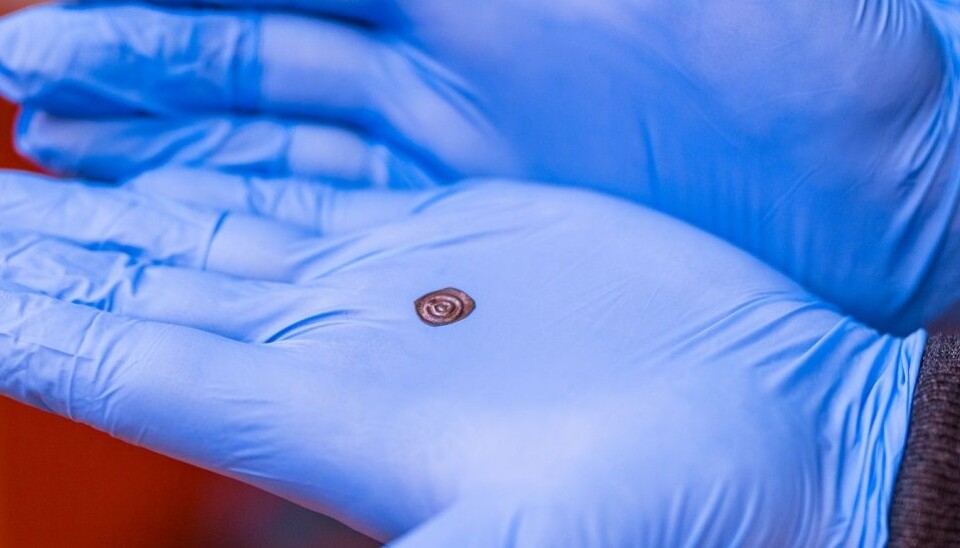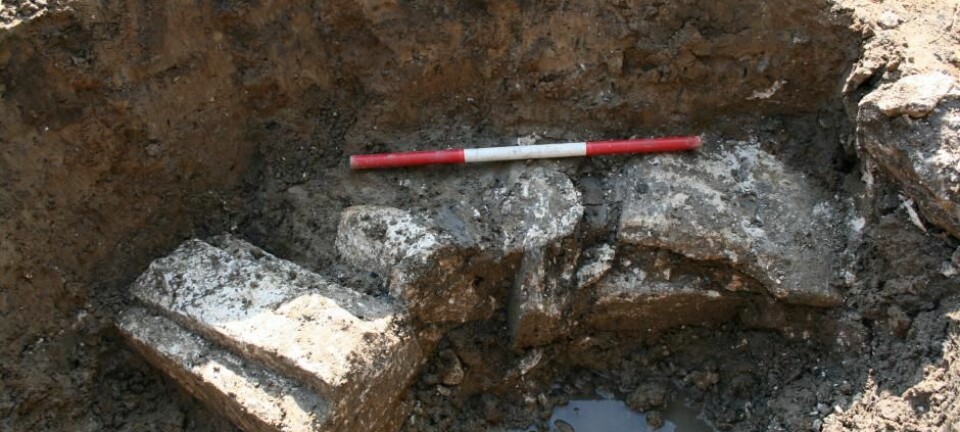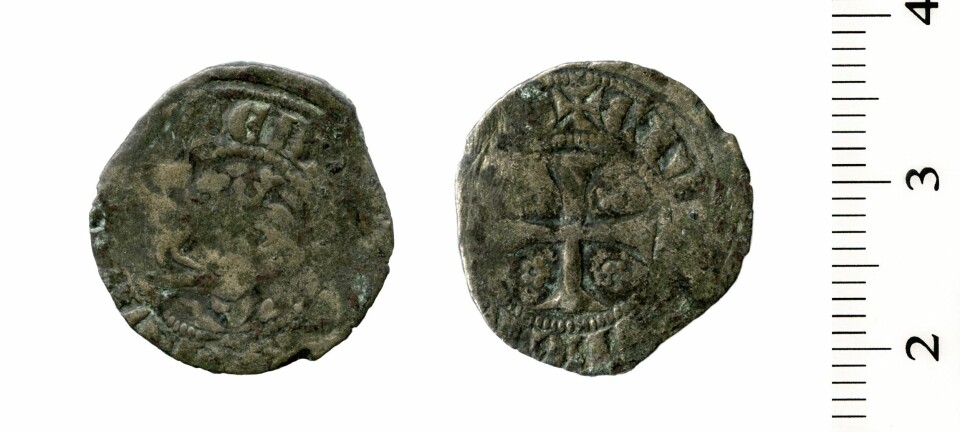An article from Norwegian SciTech News at NTNU

Pope said "no thanks" to Norwegian coins
Norway minted its own coins during much of the Middle Ages. But the coins didn’t always impress outsiders or even the Norwegians themselves.
NTNU Associate Professor Jon Anders Risvaag specializes in medieval coins. The one he’s holding weighs a mere 0.085 grams, but it’s far from the smallest. It’s called a bracteate.
“This coin is from the time of Sverre Sigurdsson,” says Risvaag. He works in the Department of Archaeology and Cultural History at the NTNU University Museum, and what he’s holding is flat, dark and small.
Sverre was king from 1177 to 1202. He has a pretty good reputation, but he also minted some of the world’s smallest coins. Most of us would have trouble identifying one. Risvaag does it in a few seconds.
One of the smallest bracteates in the museum’s collection weighs 0.042 grams, and is just a flake of a coin. The largest is around 0.3 grams. By comparison, a modern-day Norwegian krone weighs 4.35 grams – more than 100 times as much as the smallest bracteates and just over 14 times as much as the largest one.

By all appearances, they’re not very impressive things in themselves, but their backstory is pretty interesting.
15 000 bracteates
The bracteates usually had a simple design, and were only embossed with a motif on one side of the coin. They could be round, but also square or octagonal.
“We have no idea how much these bracteates were worth in their day,” says Risvaag.
Linn Eikje Ramberg at Stockholm University shared her findings on this topic in her recent dissertation defence.

Given that almost 15 000 bracteates have been found in Norway, the coins were hardly very valuable.
Found in churches
Most of the coins have been discovered in churches. Why?
“Most coins were probably lost when people made their offerings at the altar,” Risvaag said.
That would lead us to believe that people at that time must have been at least as careless and clumsy as some of us are today. They dropped coins on the floor when they were making an offering, or the coins landed on the floor in the process afterwards and rolled into cracks.
In a dark church it certainly wouldn’t have been easy to see such a small coin amidst the dust and dirt on the floor either, so it would have been easy for the person cleaning up after a service to sweep it up with everything else. Of the 359 coins discovered in Høre Church in Valdres, exactly 100 of them were in a hollow behind the altar where anything that ended up on the church floor had been swept.
That’s why the coins found there were mixed with chicken bones, glass shards and clothing remnants, among other things.
Over 2000 coins were found in Lom Stave Church alone. Mære Church revealed an additional 575 coins, Dønnes Church 527 and Alstahaug Church 386. You might think that was a lot of cash squandered, but it turns out that it’s not.
Risvaag points out that the coins that have been found amount to only two or three coins a year.
Churches that people use steadily over a long time are of course also subject to a lot of fumbling fingers, and maybe some backs that don’t bend down to pick up a coin of lesser value.
Too little silver
The silver content in Norwegian coins varied greatly. The earliest coins from CE 995 were more than 90 per cent silver, but some rulers saw their chance to scrimp on silver and save on their precious metals as they deemed necessary.
Under Harald Hardrada in the mid-1000s, the silver content dropped to 30 per cent. By the time of Eric Magnusson’s reign at the end of the 13th century, the silver content in other coins fell as low as 6-7 per cent.
“That’s so low that the coins from that era are black today,” Risvaag says.
In 1276, Archbishop Jon Raude asked Pope John XXI how he wanted his taxes to be paid and suggested that the poor-quality Norwegian coins should be exchanged for goods that could be sold for foreign silver instead. The Pope agreed with Raude’s suggestion so that instead of receiving Norwegian coins with a little silver, he would receive proper currency.
The Norwegian coins were at this point of such poor quality that only money-hungry churches would accept them.
“That was a brilliant move,” says Risvaag.
Norwegian coins remained a viable currency in Norway, but since other nations didn’t want them, the king had secured complete control. He could continue to mint coins with little silver, and make a hefty profit producing and exchanging the currency.
Long break in production
But 1387 brought an end to Norwegian coin production. Norway had become severely weakened and was well on its way to entering into a union with Sweden and Denmark. Swedish, Danish and German currencies for the most part replaced Norwegian coins.
Norway didn’t resume minting coins until almost a hundred years later, in 1483. The right to strike coins was part of Norway’s requirement for approving King John of Denmark as king of Norway as well.
In practice, production was modest when it started up again because the king had mints in Copenhagen and Malmö and had no use for Norwegian coins. Oslo minted no coins and in Bergen coins were minted for only a short period. Only the Archbishop of Nidaros in Trondheim was interested enough to continue production.
“It was a tiny mint workshop, but it was very important as a political statement,” says Risvaag.
Church and king continued their long struggle with each other. In Norway, the Archbishop of Nidaros remained the dominant power until the Reformation when he was driven out of the country in 1537. This date marks the end of the late Middle Ages in the Nordic countries.
Archaeologists discovered the Archbishop’s coin workshop in Trondheim a few years ago.
Not a big collector’s item
A while back Risvaag took his doctorate on the topic of the role of coins in Trondheim during the Middle Ages. He is one of only a few numismatists who know a lot about these coins.
“Not too many people collect Norwegian medieval coins,” says Risvaag.
The main reason is simply that collecting them is expensive and difficult. Most of the coins belong to museums and public collections, and those that are legally available are from 19th century finds, before such discoveries became protected by Norwegian law.
For example, a rather fragile bracteate from Sverre Sigurdsson’s time was recently posted online. It apparently comes from the great Dæli hoard of 1840, the largest coin hoard known to have been discovered in Norway. The asking price of the coin was just over NOK 4000. That’s expensive for 0.04 grams of bad silver, amounting to more than NOK 100 000 per gram.
But – at least some people are finally recognizing the value of the bracteates. The pope should have known better.
Reference:
Jon Anders Risvaag: Mynt og by. Myntens rolle i Trondheim by i perioden ca. 1000-1630, belyst gjennom myntfunn og utmynting. [Coin and city. The coin’s role in Trondheim city in the period approx. 1000-1630, illuminated through coin finds and minting. Dissertation for doctor philosophiae degree in Trondheim, October 2006.
































